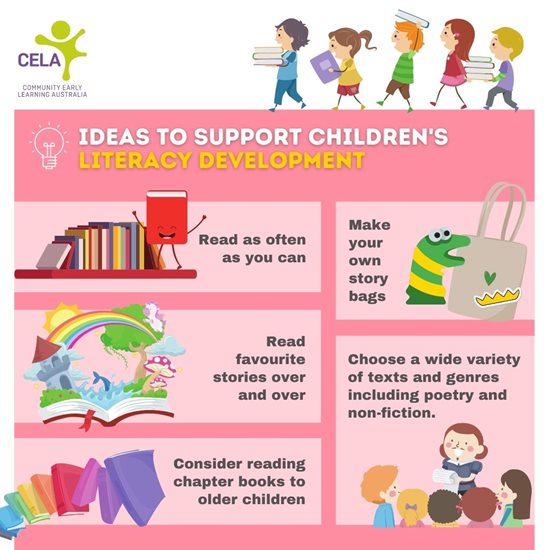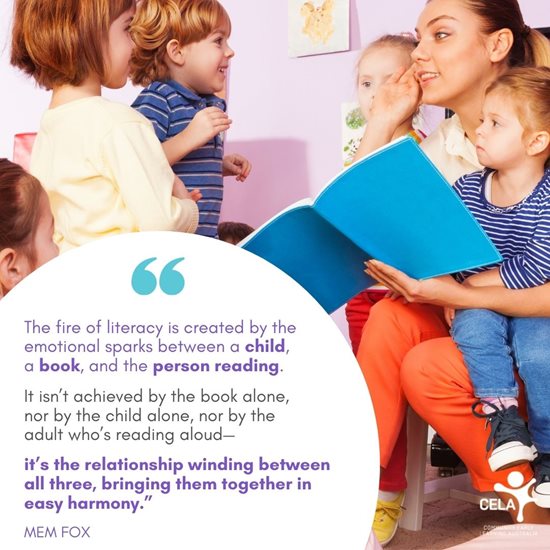As we know, early literacy is not about teaching young children how to read, but about helping them develop the skills they will need to become successful communicators, which in turn provides them with the skills they will need to start reading.
Literacy is a vital part of early years education because it can help with cognitive development, social and emotional well-being and future academic skills (EYLF Outcome 5 – Children are effective communicators – has a focus on early literacy).
Early literacy advocate Jennifer Barker shares how we can support literacy development by reading to children, along with simple ideas to foster a love of reading.
By Jennifer Barker
I clearly remember my first picture story book – “Mei Li”. My aunt in New Zealand sent it by post. I was eager for my mother to read the story because as a child aged five in 1963 I had never seen the faces, the houses or the clothing of the people of China that were depicted by author and artist Thomas Handforth. I Couldn’t wait to find out more.
Was it in that exact treasured moment that my interest in reading began?
Was I destined to become an avid reader?
Remembering back, my mother always read to me. Little Golden books were the stories of the day, along with anthologies of poems AND of course much loved fairy tales such as The Gingerbread Man and Little Red Riding Hood that we still read to children today.
So why is reading to children so important?
According to Raising Literacy Australia, reading to young children expands their vocabulary, improves memory, and allows children to practice listening skills. It also develops thinking skills and the imagination. It allows us to lay the foundations of emerging literacy.
Children’s emergent literacy skills include:
- General knowledge about handling books – the cover, spine, illustrator, author, turning pages, left to right progression of letters in words and sentences
- Recognising the names of letters
- Developing phonological awareness (the sounds letters make)
- Building listening skills and attention span for emerging comprehension
- Recognising how a story is organised (a beginning, middle and ending)
- Understanding that picture and print are linked
- Building the connection between images and how they inspire emotions
Do the math – how two books a day turns into 3,600 stories
I was amazed to do the math – if a child hears two books a day from birth to 5 years, they will have heard over 3,600 stories by their fifth birthday. Just imagine the number of words, phrases and concepts they will have been exposed to in that time!
In addition to that, research has shown that reading to children at age 4-5 every day has a significant positive effect on their reading skills and cognitive skills (i.e., language and literacy, numeracy and cognition) later in life.
How we can support children’s literacy development
So, what can we as educators do to support children’s literacy development and ultimately their love of books and reading?
Apart from being a good reading model, here are some ideas:

1. Read as often as you can
Don’t confine book reading to ‘a group time’ or before ‘rest’. Reading can happen anywhere, anytime so place books in baskets and on shelves throughout the learning space both indoors and outdoors. Add information texts to activity areas to support further understanding and if we can’t find the answer in a book use technology
2. Invest in or make your own story bags
Place a favourite book and props or puppets in the bag to help tell the story. Invite children to act out the story as you read it – this will encourage language development and the understanding of the sequence of events.
3. Read favourite stories over and over again.
Children learn and develop greater understanding through repetition. Perhaps the book represents a safe and happy place for a child and the quality time spent together will support relationship building.
4. Choose a wide variety of texts in a variety of genres
Focus on fiction one day, poetry another, and include non-fiction books with informative text. Following children’s interests will initially gain their attention and then scaffold future understanding and learning. Introduce texts specific to the cultural identity of the children you teach. It is very empowering for a child to see themselves in the curriculum and it broadens horizons for everyone.
5. Consider reading chapter books to older children
Listening to a story without pictures allows them to use their imagination to recreate the story in their mind. Hearing new words helps build vocabulary, and concentration is essential to recalling events as the story progresses perhaps over days and weeks.
Author Mem Fox says:

Whilst that first precious picture book began my literacy journey, I also learnt at my mother’s knee that books take us away, make our world bigger, and prepare us for future learning. When she read to me every day, I learnt that reading is fun, especially when shared with someone who takes time to be with you.
References
(1) Raising Literacy Australia – Starting Blocks article https://www.startingblocks.gov.au
(2) Reading to young children: a head-start in life. 2012: G. Kalb and J.C. van Ours. https://www.education.vic.gov.au/documents/ about/research/readtoyoungchild.pdf
(3) https://memfox.com/
About Jennifer
Jennifer has recently joined CELA as training facilitator following a 42-year career in Early Childhood Education. Her most recent role was as 2IC, joint Educational Leader and provider of a Music and Movement Program.
After attending a training where the amazingly talented author Mem Fox had spoken, Jennifer realised the many values of reading and importantly the 3-part connection between reader, child and book.
When teaching, her program allowed for reading to happen anywhere and anytime in the day – happily re reading favourite stories and creating opportunities for children to dramatise, sing, write and draw whilst on the journey to Literacy.
Live Training: LITERACY IN THE EARLY YEARS

– Can you identify emerging literacy skills?
– Do you know of strategies and tools educators can provide to support these emerging skills?
– Are you aware of the difference between reading to learn and learning to read?
FIND OUT MORE